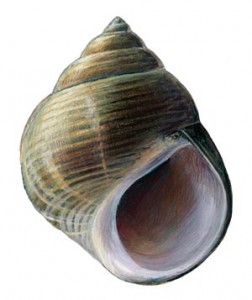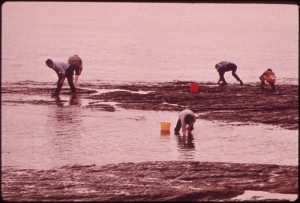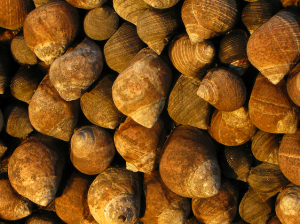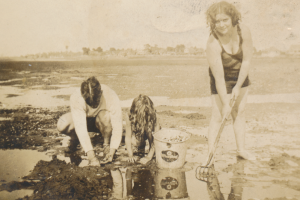
Littorina littorea
Native range: Atlantic Europe
Invasive Range: Northeast coast of North America
Habitat: Intertidal. Often found on rocky shores, pilings, and rock jetties
Description: About one inch long. Spiral shell is typically black, brown, or gray
The common periwinkle, which first appeared in New England in the 1860s, is now found along the coast wherever there’s hard substrate–rocks, riprap, broken concrete, or docks—from Labrador to Maryland. About the diameter of a quarter, the snail can be recognized by the blunt shape of its shell and a white inner lip. When disturbed, it retreats into its shell.
Clinging to barnacle-laden boulders just above the low-tide line, the snail might look innocent, but as it feasts on native algae, it can scrape the intertidal down to bare rock. It eats the eggs of other mollusks and can stunt the growth of native limpets. It can destroy salt marshes with its voracious appetite.
Beneath the tides, the indigenous dog whelk, Busycon canaliculatum, eats periwinkles as readily as it consumes natives, but in the intertidal zone, the snail has few predators–at least on this side of the Atlantic. More than 700 common periwinkles can be found in a square yard along parts of the shore.
Most biologists believe that common periwinkles arrived in ballast rocks from Europe, or were intentionally released by colonists looking for a familiar source of coastal food. But not everyone subscribes to this standard invasion story. Geneticists John Wares and Cliff Cunningham found that local periwinkles have genetic signatures that differ from the European population, indicating that the area along the southern edge of the Northumberland Strait in the Canadian Maritimes may have served as a refuge for periwinkles during the last ice age. In the nineteenth century, the intertidal snails expanded their range to the Gulf of Maine and US shores, the snails probably unintentionally transported to the Atlantic coast of Nova Scotia by ships.
Although there was never much demand for periwinkles in the US in the nineteenth century, thousands of tons of them were shipped to London markets, where they were sold in “winkle shops.” They’re still enjoyed in British seaside resorts, with vinegar and a few grains of sand blown in, a cup of hot tea with milk and sugar on standby, and rain on the way.
Though that tradition has never caught on here, you can find these snails in some large cities on the northeast coast. While collecting crabs in Nova Scotia, I met a fisherman gathering periwinkles in the Bay of Fundy. The five-gallon plastic bucket he was carrying had nickel-size holes, to let the small, unmarketable snails slip through. He told me he made a decent living selling periwinkles to markets in New York City. There, in Chinatown, the shells are sold with the peaks chipped off so you can suck the meat out. They’re sold in Italian markets. But my great-grandmother, born in Naples, didn’t bother. On Saturday, she went to Rockaway Beach instead. She gathered periwinkles from the jetties to go with the clams and mussels she found, putting it all in her tomato sauce for Sunday dinner.
From the “Guardian,” Letters, May 31, 2012
Did no one eat winkle sandwiches? Before the second world war, on Sunday afternoons, a barrow was pushed around the streets of east London, laden with celery and a pile of winkles. Our mum would buy a head of celery and a pint of winkles. We children would be given a pin and a pile of winkles each, and proceed to manoeuvre the winkles out of their shells. After some time we would have enough to create a sandwich. It kept us quiet…
Elsie Grimes
Ryde, Isle of Wight
Scituate Periwinkles with Hard Cider and Dulse
Loyal Nine in Cambridge, Massachusetts, celebrates New England cuisine. Chef Marc Sheehan shows how these snails, which have been in New England since the nineteenth century, could become a tasty addition to locally sourced seafood. You can find the recipe here. For those who prefer to keep their prep time to a minimum, check out Jacques Pépin’s recipe below.
Spaghetti and Periwinkles
This is a simple variation of the Sunday tomato sauce made by my great-grandmother, who would never waste a day at the beach without collecting at least a few mollusks. Although periwinkles were one of her favorites, she also included little necks, razor clams, and mussels in her sauce–essentially any mollusk she could find along the shore. She prepared her meals in a cabán, a screened-in summer kitchen in her yard, surrounded by children and grandchildren. It wouldn’t hurt to have a few assistants of your own to help remove the snails from their shells.
Serves 4 to 6
about 2 cups of periwinkles in shells
3 cloves garlic
1 teaspoon dried parsley
1 tablespoon olive oil
3 cups plum tomatoes from the garden, or a 20 oz. can of imported Italian plum tomatoes
salt and pepper to taste
1 pound spaghetti
grated Parmesan cheese
Italian bread
Wash the snails in cold water. Add periwinkles to a pot of boiling water, along with a small handful of salt to shrink and toughen the meat. (This eases their removal.) The snails are ready when the operculum falls off.
Remove the periwinkles from their shells with a nutpick or pin. (This can be time consuming, find an assistant if you can.)
Sauté garlic in olive oil. Add parsley and tomatoes, and cook for about 30 minutes.
Boil four quarts of water. Add spaghetti, and remove when soft but still firm to the bite. At the same time that you add the spaghetti, add the periwinkles to the sauce.
Mix the pasta and sauce in a warm bowl. Serve hot, with crusty Italian bread and grated Parmesan cheese.
Bigorneau à la Madison
Jacques Pépin
Dean, French Culinary Institute
Cohost of “Jacques Pépin Celebrates”
In France, periwinkles are known as bigorneau. The fact that they’re not native to Long Island Sound doesn’t prevent Jacques Pépin from serving them at his seaside home in Connecticut. When I rang him up, he told me that he just collected some periwinkles along the shore with his brother. He served the invaders with chilled white wine at his home that weekend.
Serves 4 to 6
3 cups periwinkles
1 tablespoon olive oil
1/2 teaspoon Tabasco
1/4 cup dry white wine
In a large bowl of cold water, wash and rub together approximately three cups of periwinkles, each about one inch in diameter. Lift the periwinkles from the water and put them in a medium saucepan, preferably stainless steel.
Add the olive oil, Tabasco, and wine to the periwinkles and bring to a hard boil. Cover and boil for 2 to 3 minutes, removing the lid and stirring them once or twice while they cook. Transfer to a bowl, let cool to warm, and enjoy.
Straight pins can be used to remove the snails from their shells. (Pépin notes: “At our house, we stick several pins into a wine cork and pull them out as needed at the table.”) The operculum should be removed before sticking a pin into the shell opening and extracting the flavorful meat.
Serve with an apéritif; Jacques Pépin prefers Campari and soda, or white wine.
Periwinkle Fritters
adapted from Euell Gibbons, Stalking the Blue-Eyed Scallop
For those who like their mollusks fried, fritters are a delicious, if somewhat labor-intensive, seashore treat. If possible, find an assistant to help remove the snails from their shells.
Serves 2 to 4
2 cups cleaned periwinkles (about 4 1/2 cups in shells)
1/2 cup flour
1/2 teaspoon baking powder
1 egg
Wash the snails in their shells in cold water. Add periwinkles to a pot of boiling water in a saucepan, along with a small handful of salt to shrink and toughen the meat. (This eases their removal.) The snails are ready when the operculum falls off.
Remove the periwinkles from their shells with a nutpick or pin.
Beat the egg and mix with flour, snails, and salt, until flour is evenly dampened. Form the batter into little cakes with wet hands.
Fry cakes in a well-greased frying pan until golden brown on both sides. Serve with crusty bread and a salad of wild seaside plants, preferably invasive.































{ 18 comments… read them below or add one }
Been selling the largest periwinkles in maine for years…would love to expand market with somone interested in picking them up in large quantity…
Heading to Newfoundland this May/June. One of the highlights will be clam digging and snail (periwinkle ) picking. . . . Did it for years in NFLD and Nova Scotia. I like it best steamed or boiled in salty water, picked out of the shell with a safety pin or sewing needle, dipped in butter and garlic, delicious chewy little critters. Enjoy!
There is a commercial fisherman in Maine that harvests and ships them to you….
Hi how much a pound ? Is anyone selling them?
Yeah, these freeze well, we used to gather them in Narragansett Bay.
Can’t say it was intentional, but when quohogging, or clamming, we’d
keep them for sauce. Fresh tuna chunk gravy, clam gravy, squid gravy,
periwinkle gravy.. but they are also good on toast with some olive oil
and garlic. Make me want some.
where in Narragansett Bay ? I’ll be there today, leaving Cape this afternoon….
Thanks,
Toni
I used to pick them from the large rocks in Rhode Island after high tide and the clean seawater had washed over the rocks, have loved them all my life. I cooked them in a tomato sauce and ate them with a pin for days. No one sells them around here but I think there is a shipper from Vancouver out there.
I am looking for someone to buy periwinkles in Ireland. I can have a constant supply of them for sale.
on cape cod – where can we go periwinkle picking ? OR at least the name of a seafood market that sells them ?
I am a Maine commercial fisherman and hand harvest “winkles”, periwinkles. I can get you all you want picked to order fresh that day and shipped that day. Email me if you are interested in prices or have a question.
I am interested in buying periwinkles can you advise me on poundage and pricing
Hi I have looked on every website wiki everywhere on how to clean live common periwinkle snails but have not found nothing that looks real could you tell me how to clean live common periwinkle snails minding that this is my first time ever dealing with Gastropods
you just steam them like other shellfish. Then simply use a small toothpick to pick out the meat and tear off the “trap door” and eat the rest. Dip in any sauce or sauté in a sauce of choice.
I suggest you label this as “periwinkle snail”. Periwinkle, the plant, is toxic. A casual glance at the main page could cause someone to think the plant, another invader, is edible.
Where in the tampa, fl area or surrounding area can i find a restaraunt or place that sells periwinkles? Thank you for your time and help.
Please see my post if you are interested in periwinkles, sticktuna@gmail.com
Where can a person buy these periwinkles in New Jersey or Pennsylvania?
I have seen them in DC and New York. They are popular in Chinese markets, so that might be a good place to start. Of course, foraging is the best idea, but you might have to go to New England for that!
{ 3 trackbacks }